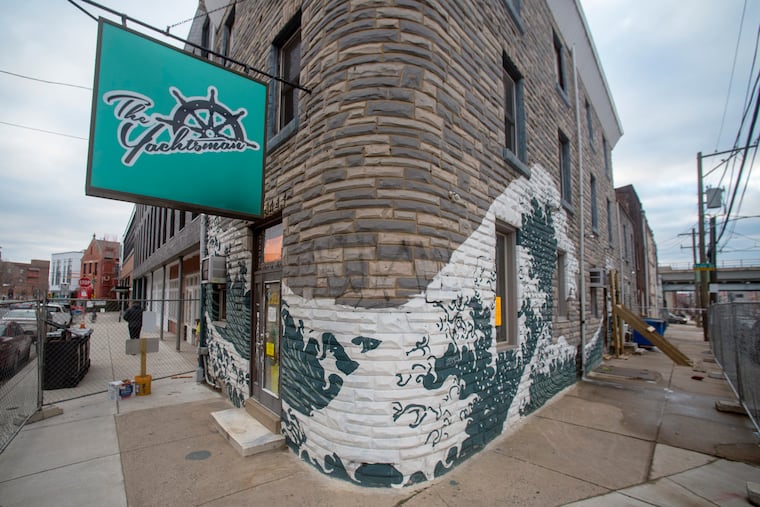The discreet charm of Fishtown’s working-class architecture
Stone facade on Fishtown bar is totally fake and totally great.

Most of the architecture we celebrate is created by trained professionals who have spent years honing their craft and aesthetic vision. But there is another kind that is also worthy of our attention: the elaborate DIY improvements dreamed up by homeowners and small businesses to beautify their buildings. Call it working-class architecture.
Philadelphia is full of these improvisational gems, but few compositions are as arresting as the corner bar at the corner of Frankford Avenue and Jefferson Street in Fishtown. Tightly veneered in gray-toned stucco that has been molded and scored to look like more expensive granite blocks, it rears up like a miniature castle. What sets it apart from other faux stone rowhouses is a second intervention: a bright blue, Japanese-style painting of a crashing wave that wraps around its rounded corner.
The juxtaposition of the two radically different aesthetics couldn’t be more jarring — or intriguing. While the composition is the work of two owners, layered on over a period of decades, we get to experience their clashing visions in a single glance. The high-art mural, a copy of Hokusai’s Great Wave off Kanagawa, both subverts and completes the humble stucco facade.
The bar, most recently known as the Yachtsman, was probably built as a single-family, red brick rowhouse sometime between the Civil War and 1875. Like so many corner rowhouses in Philadelphia from that period, the building was given a rounded edge to address the intersection. A decorative cornice, visible in a 2007 Google Street View, further emphasized its prominent position in the city grid.
At the time the house was constructed, Fishtown was a prosperous working-class neighborhood, dotted with humming factories and stately parish churches. Fishtown remained a relatively stable place well into the second half of the 20th century, long after residents in other neighborhoods had started leaving the city for bigger houses in the suburbs.
Even with the best of care, the house’s original brick facade would have required serious facade maintenance by the 1960s, when it was nearing its centenary. Because that work was probably expensive, the owners turned instead to a stucco product sold under such brand names as Formstone, Perma-stone or Ros-stone.
Formstone, the best known of the three, was invented in 1937 by Albert Knight, a Baltimore resident looking for an inexpensive way to shore up the city’s deteriorating rowhouse facades. The homes were built with soft, spongy bricks that tended to flake. Thanks to Knight’s relentless salesmen, Baltimore’s rowhouse neighborhoods were transformed in a few years into Formstone kingdoms. Filmmaker John Waters has celebrated the material as the “polyester of brick.”
Knight’s sales force soon expanded into Philadelphia, where flaking brick was also a problem. Aluminum siding had not yet come into wide use. Denise Mayer, who grew up in Fishtown, remembers the Formstone salesmen going door-to-door along Crease Street, a block east of the bar.
As part of their sales pitch, they promised residents a lifetime free from leaks and peeling paint. Rather than seeing Formstone as a cheap fix, many residents embraced the material as a neat and elegant solution. The investment in repairs was also a sign of their long-term commitment to the neighborhood. Easily a dozen Fishtown houses treated with Formstone remain in pristine condition to this day.
Mayer believes the Frankford Avenue house was converted into a corner bar and rooming house sometime in the 1970s. The bar, originally called Dyer’s, catered to the working-class neighborhood, serving Budweiser and no-nonsense drinks. But by the Aughts, the writing was on the wall. Fishtown was changing. Dyer’s hung a sign over the entrance urging Fistowners to “Try Our Fine Food.”
In 2014, Dyer’s gave up, and the building was taken over by Tommy Up, a flashy restaurateur who repositioned the humble dive as a Polynesian-themed tiki bar. He commissioned the Hokusai mural as part of the rebranding. But after Up flamed out in 2017, the Yachtsman closed.
Almost immediately, another bar owner, Nick Moore of Gaslight, announced that he wanted to convert the building back into a neighborhood bar. Nothing has happened, and last month the Department of Licenses & Inspections detected that some of the faux stone was peeling off the facade and issued a violation. That explains the chain-link fence that now surrounds the house.
Because I couldn’t reach the owners, S&L Real Estate, it’s unclear what’s in store for the Dyers-Yachtsman-Hokusai house. If they’re smart, they’ll keep the Formstone. There is probably no better way to honor the complexity of Fishtown’s heritage than to preserve a faux stone facade.